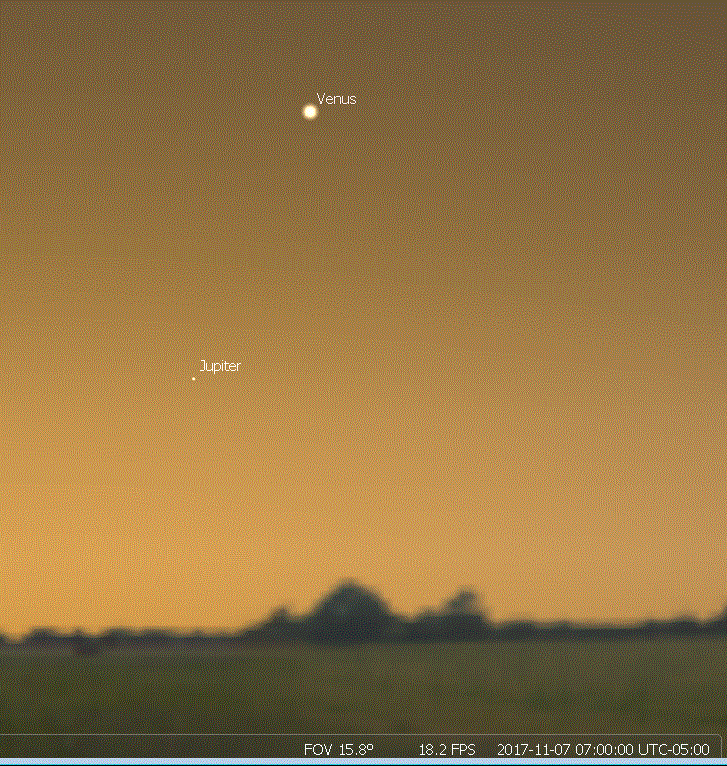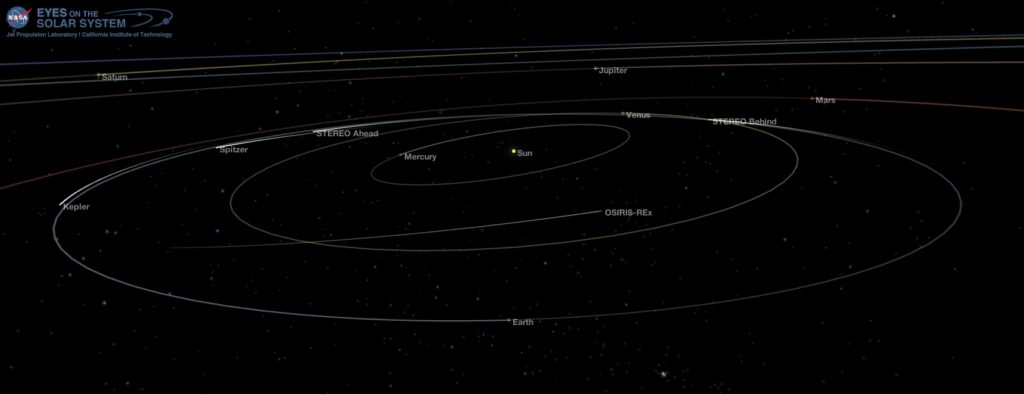Keep your eyes on the southeastern predawn sky for the next several days – Jupiter returns to the morning sky and has a multi-day conjunction with Venus. The planets will appear closest on the morning of the 13th.
The waning gibbous Moon and is high in the southwestern sky before dawn; the Moon will be at third quarter Nov. 11th. I actually got to see the Moon this morning in a rare break through the Michigan clouds!
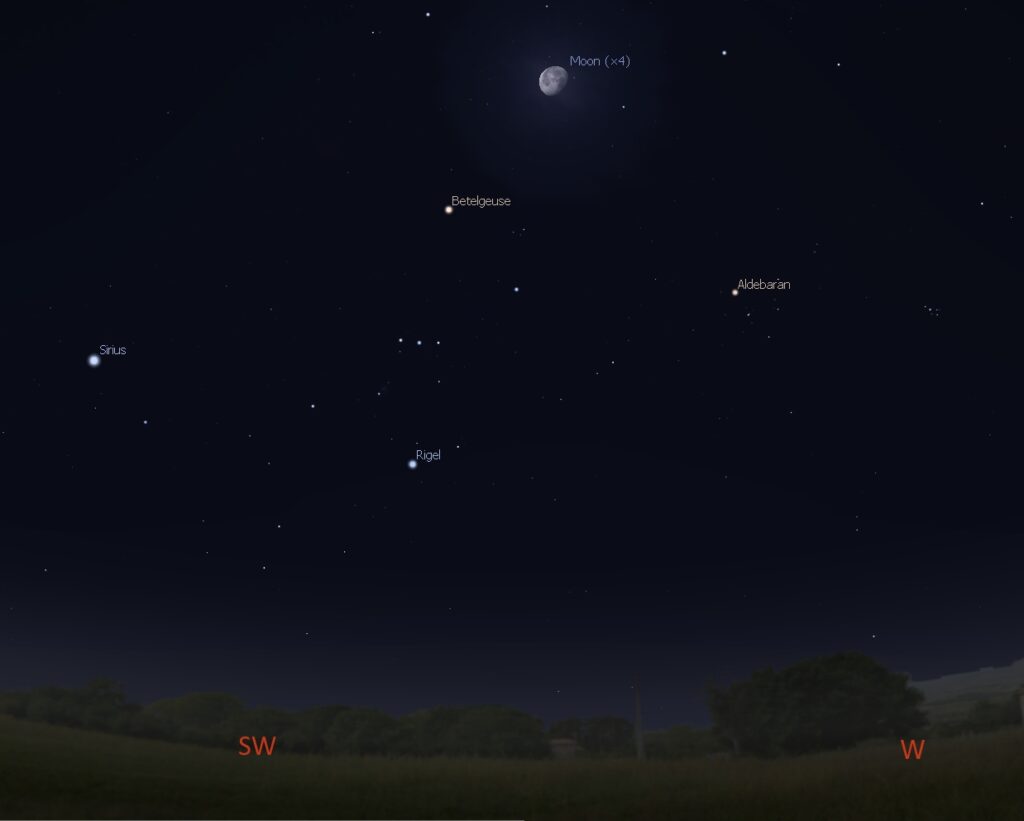 The Moon near Orion in the southwestern predawn sky on Nov. 7, 2017. Credit: Stellarium / Bob Trembley.
The Moon near Orion in the southwestern predawn sky on Nov. 7, 2017. Credit: Stellarium / Bob Trembley.Saturn is barely visible above the treetops to the southwest after sunset. Soon, Saturn will be behind the Sun, in relation to the Earth, and will not be visible again until early March of 2018.
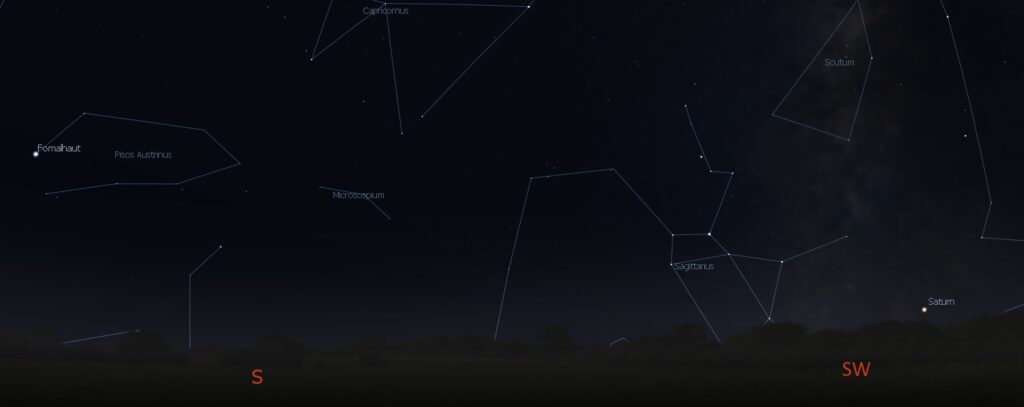 Saturn low on the southwestern horizon after sunset on Nov. 7, 2017. Credit: Stellarium / Bob Trembley.
Saturn low on the southwestern horizon after sunset on Nov. 7, 2017. Credit: Stellarium / Bob Trembley.The Sun has no visible sunspots again this week… it looks pretty boring through a white-light telescope.
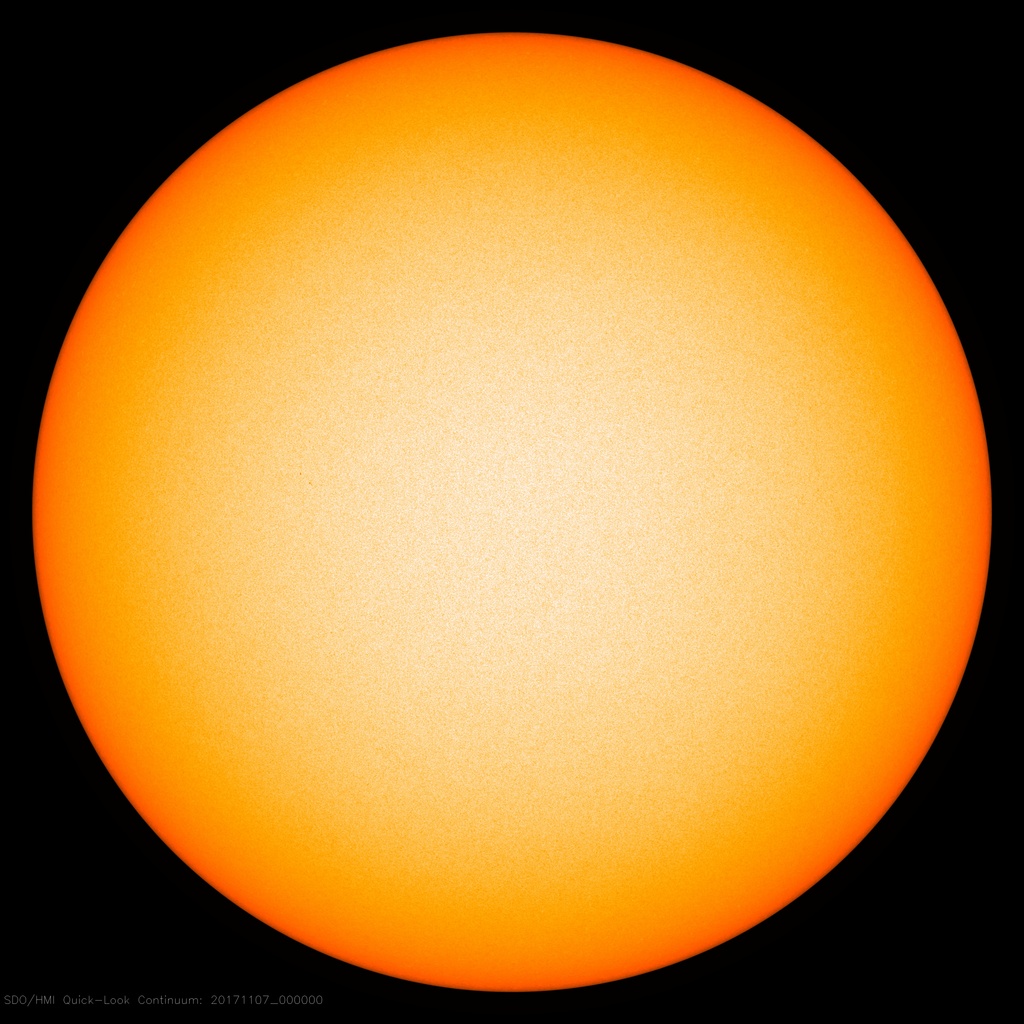 The Sun – Nov. 7, 2017 – Helioseismic and Magnetic Imager (HMI). Image courtesy of NASA/SDO and the AIA, EVE, and HMI science teams.
The Sun – Nov. 7, 2017 – Helioseismic and Magnetic Imager (HMI). Image courtesy of NASA/SDO and the AIA, EVE, and HMI science teams.But the view through a hydrogen-alpha telescope (or from the Solar Dynamics Observatory) is a little more exciting.
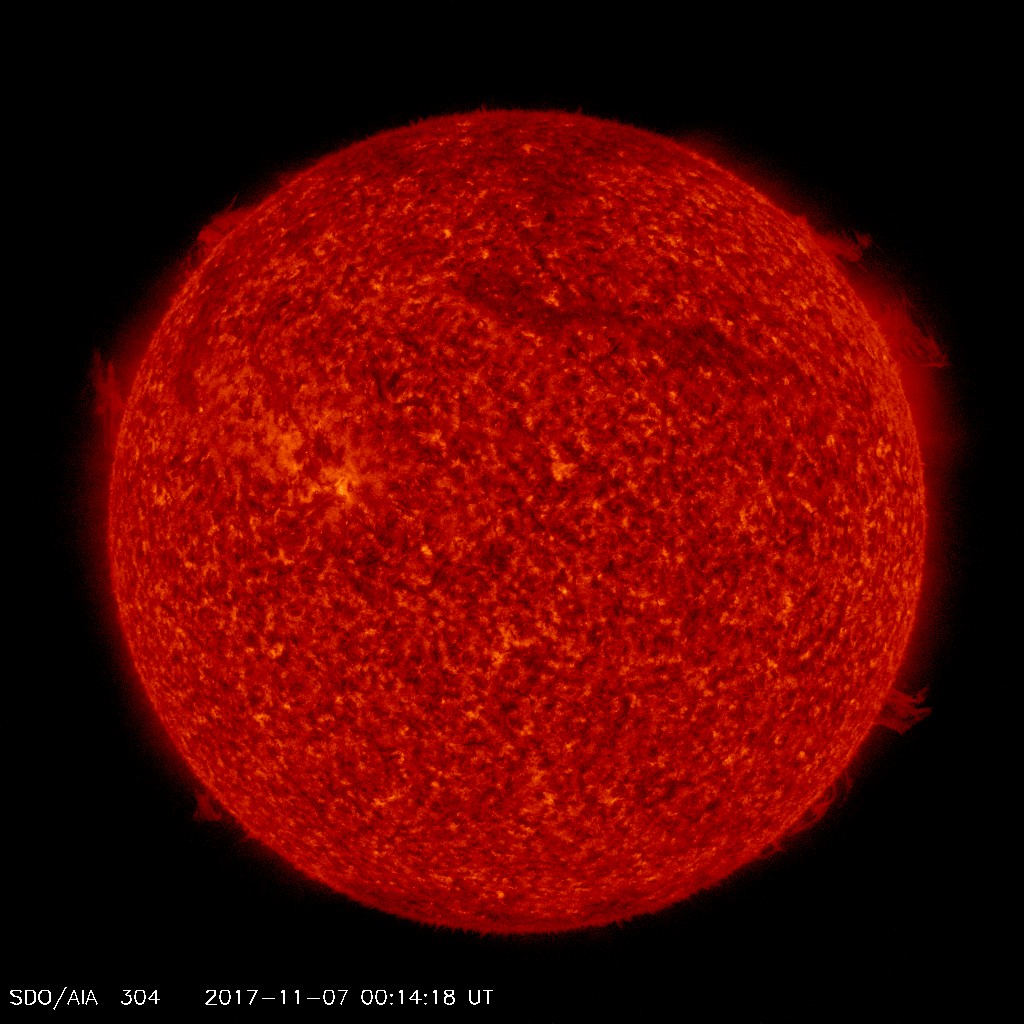 The Sun in 304 angstroms showing several prominences – Nov. 7, 2017. Image courtesy of NASA/SDO and the AIA, EVE, and HMI science teams.
The Sun in 304 angstroms showing several prominences – Nov. 7, 2017. Image courtesy of NASA/SDO and the AIA, EVE, and HMI science teams.Here’s a close-up of prominences on the Sun’s eastern limb:
 Close-up of the Sun in 304 angstroms – Nov. 7, 2017. Image courtesy of NASA/SDO and the AIA, EVE, and HMI science teams.
Close-up of the Sun in 304 angstroms – Nov. 7, 2017. Image courtesy of NASA/SDO and the AIA, EVE, and HMI science teams.The coronal hole I’ve been mentioning for a few weeks has migrated back to the Sun’s northern hemisphere. Spaceweather.com says: “NOAA forecasters say there is a 45% chance of polar geomagnetic storms on Nov. 7th, increasing to 60% on Nov. 8th as Earth enters a stream of fast-moving solar wind. The gaseous material is flowing from a hole in the sun’s atmosphere. Isolated periods of G1-class storming will likely spark bright naked-eye auroras around the Arctic circle and photographic auroras in northern-tier US States from Maine to Washington.”
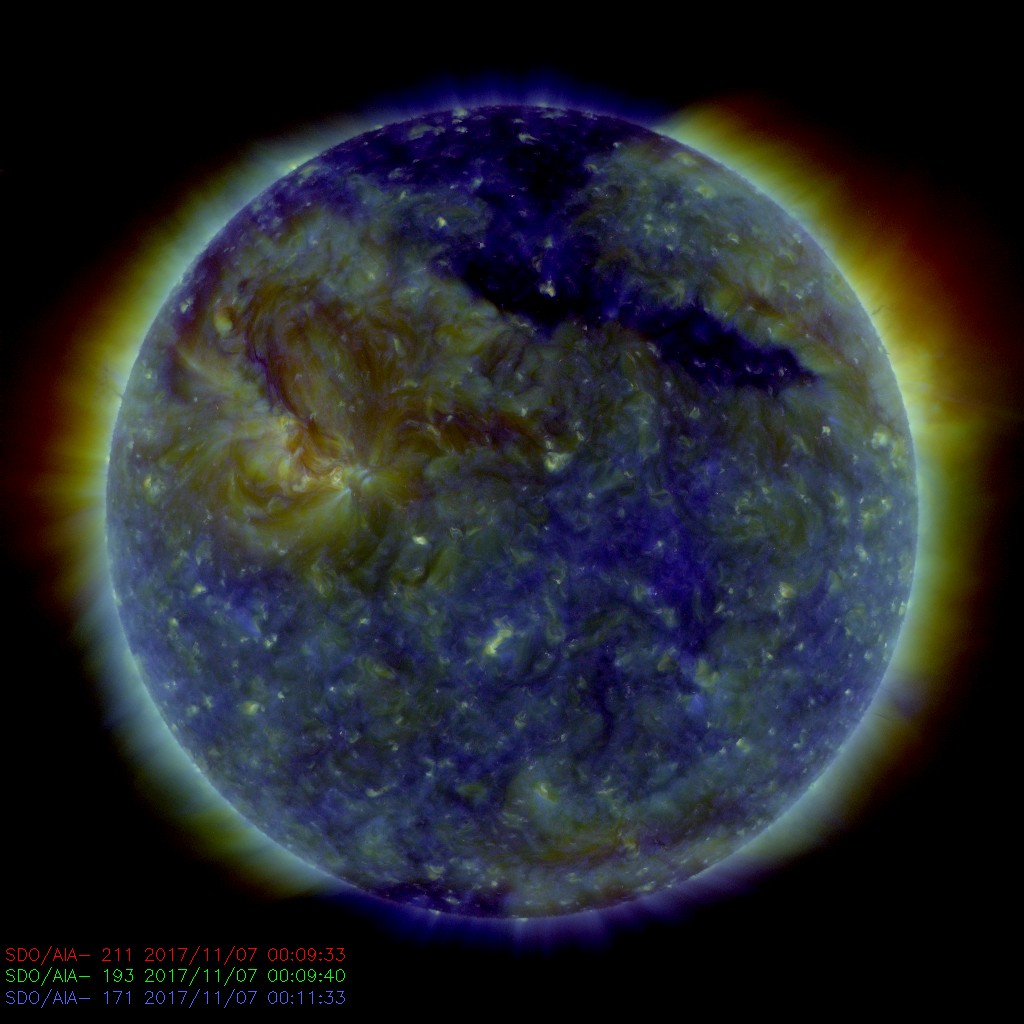 The Sun in multiple frequencies – Nov. 7, 2017 – Atmospheric Imaging Assembly (AIA) 211, 193, and 171 angstroms. Image courtesy of NASA/SDO and the AIA, EVE, and HMI science teams.
The Sun in multiple frequencies – Nov. 7, 2017 – Atmospheric Imaging Assembly (AIA) 211, 193, and 171 angstroms. Image courtesy of NASA/SDO and the AIA, EVE, and HMI science teams.You can view the Sun in multiple frequencies, in near real-time here: SDO-The Sun Now
The Inner Solar System
This is the position of the planets in the inner solar system using NASA Eyes on the Solar System. Note the position of Venus and Jupiter opposite the Sun from the Earth.
Update:
The asteroid visitor from interstellar space now has a name: ‘Oumuamua. It also caused a “slight nomenclature problem” described below:
M.P.E.C. 2017-V17 Issued 2017 Nov. 6, 21:00 UT
The Minor Planet Electronic Circulars contain information on unusual
minor planets and routine data on comets. They are published
on behalf of Division F of the International Astronomical Union by the
Minor Planet Center, Smithsonian Astrophysical Observatory,
Cambridge, MA 02138, U.S.A.
Prepared using the Tamkin Foundation Computer Network
MPC@CFA.HARVARD.EDU
URL http://www.minorplanetcenter.net/ ISSN 1523-6714
NEW DESIGNATION SCHEME FOR INTERSTELLAR OBJECTS
The discovery of A/2017 U1 has presented a slight nomenclature problem.
Since both the original and future barycentric orbits for this object are
significantly hyperbolic, this object is not bound to our solar system and the
current apparition is likely to be the only time that the object is observable.
Due to the unique nature of this object, there is pressure to assign a
name. The minor-planet designation scheme does not allow a name to be assigned
to this object based on the brief arc of observation.
Recent e-mail exchanges between the IAU General Secretary, the IAU
Division F President, the co-chairs of the IAU Working Group on Small Body
Nomenclature and the Minor Planet Center have discussed this nomenclature
issue. A solution has been proposed that solves the problem. A new series of
small-body designations for interstellar objects will be introduced: the I
numbers. This new sequence will be similar in form to the comet numbering
system and assignment of the numbers will be handled by the Minor Planet
Center.
Provisional designations for interstellar objects will be handled using
the C/ or A/ prefix (as appropriate), with the designation using the comet
system.
Accordingly, the object A/2017 U1 receives the permanent designation 1I
and the name 'Oumuamua. The name, which was chosen by the Pan-STARRS team, is
of Hawaiian origin and reflects the way this object is like a scout or
messenger sent from the distant past to reach out to us ('ou means reach out
for, and mua, with the second mua placing emphasis, means first, in advance of).
Correct forms for referring to this object are therefore: 1I; 1I/2017 U1;
1I/'Oumuamua; and 1I/2017 U1 ('Oumuamua).
This first interstellar object is being handled as a special case. A
small committee of the WGSBN will be created to codify the circumstances under
which an object will qualify for an I-number and the rules that will apply to
the names, bearing in mind the precedent set by this case. A formal report will
follow their deliberations.
Gareth V. Williams (C) Copyright 2017 MPC M.P.E.C. 2017-V17
Apps used for this post:
Stellarium: a free open source planetarium app for PC/MAC/Linux.
NASA Eyes on the Solar System: an immersive 3D solar system and space mission app – free for the PC /MAC.
